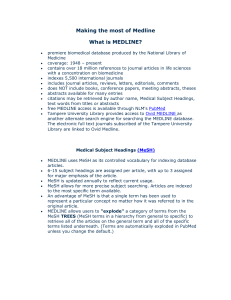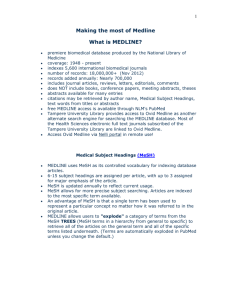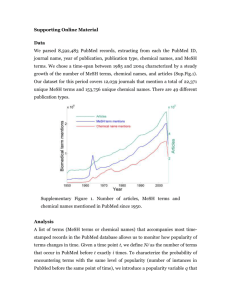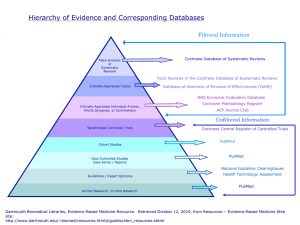MeSH
advertisement
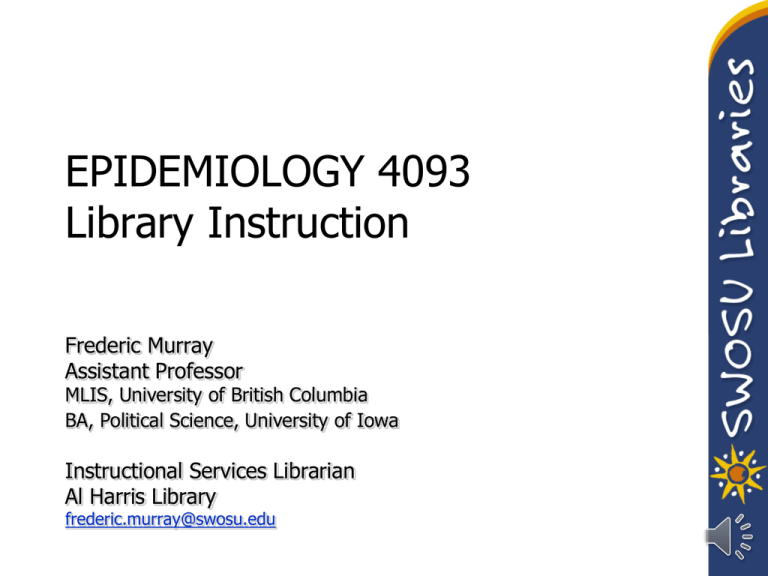
EPIDEMIOLOGY 4093 Library Instruction Frederic Murray Assistant Professor MLIS, University of British Columbia BA, Political Science, University of Iowa Instructional Services Librarian Al Harris Library frederic.murray@swosu.edu Useful Links • MeSH • 101 Study Design • 10 Simple Rules for Writing A Literature Review Resources • MeSH PubMed Discovery (Al Harris New Search Tool) • CINAHL – Subject Subset i.e. Public Health – Clinical Queries i.e. Etiology – Publication Type i.e. Systematic Reviews, Tables & Charts • MEDLINE – Publication Type i.e. Meta-Analysis • UpToDate – Clinical Reviews Library • Peer Review • Boolean • Keywords • Resources & Strategies – MeSH (Thesaurus) – Discovery/Databases/Journals – Reading Citations/ ILL – Folders/Refworks – Class Exercise The Decameron (1353) Giovanni Boccaccio Here, it is necessary to count. 1787-1872 19th Century physician and proponent of the numerical method (relying on counts, not impressions) to understand the natural history of diseases such as typhoid fever. Information Literacy for Health Professionals • Inquiry is the Norm • Problem Solving the Focus • Critical Thinking a Natural & Ongoing Process Assignment: Literature Review • January 31: 5 APA formatted citations & topic submission • April 17: Final Paper – 2000 words (8 pages) APA – 10 References Peer Reviewed Search Fundamentals • Boolean – And – OR – Not • Controlled Vocabulary • Keywords - Epidemiology Epidemic Population at risk Cohort studies Survival Rate Morbidity Boolean • AND = Narrow • OR = Expand • NOT = Exclude Boolean Operators • Connect keywords only • Must be placed between keywords • AND – Narrows your search • OR – Expands your search with synonymous terms • NOT – Excludes words from your search – If used too much, it can work against you! What’s Out There? Information Age • There are 7827 articles relevant to family practice published every month • That’s 260 articles a day (every day) to keep up…. Study Design 101 Yale University School of Medicine Filtered Information Appraises the quality of studies and often make recommendations for practice Unfiltered Evidence is not always available via filtered resources. Searching the primary literature may be required Lit. Review Strategy • References in retrieved articles and systematic reviews should be checked. • Supplementary searches should be undertaken as appropriate. Search relevant websites for national statistics, insurance data, health surveys and other relevant data. Resources • MeSH PubMed Discovery (Al Harris New Search Tool) • CINAHL – Subject Subset i.e. Public Health – Clinical Queries i.e. Etiology – Publication Type i.e. Systematic Reviews, Tables & Charts • MEDLINE – Publication Type i.e. Meta-Analysis • UpToDate – Clinical Reviews Medical Subject Headings • MeSH is the National Library of Medicine's controlled vocabulary thesaurus • Using MeSH terms will improve your search results • MeSH Homepage Video Tutorial Using MeSH • MeSH is an online medical thesaurus • It links to PubMed: online database of citations run by the National Library of Medicine • Use Discovery (Al Harris) to locate articles…full text or ILL Definitions • Index – Tool that arranges (by author, title, or subject) citations to articles in a selected group of periodicals. • Database – A large, regularly updated file of digitized information related to a specific subject or field. • Search Engine – Computer software designed to help the user locate information available at sites on the World Wide Web Importance of Indexing • • • • • Do you want articles on labor (as in work) or articles on labor (as in giving birth)? Or is it labour? Indexing facilitates more precise search statements, especially for topics that are vague or ambiguous. Using index terms also helps you avoid the need to think of every possible synonym or alternate spelling of your search terms. Indexing means the citations in the database are assigned terms from a controlled vocabulary; not all databases use a controlled vocabulary, however. Index terms are sometimes called descriptors or thesaurus terms; in PubMed they are called Medical Subject Headings, or MeSH • Go to MeSH Exercise • Search Bird Flu • Use PubMed Search Builder – Select two subheadings related to epidemiology/numerical data – Find two articles – Use Discovery to locate articles • Add to Temporary Folder – Groups 2-3 Exercise: PubMed • Could you get full text copies in Discovery? • Issues? • Solutions? PubMed- For Lit. Review • Article types – Reviews • Text Availability – Free Full Text, Discovery, ILL • Publication Dates – Custom Years Discovery Tool • Searches entire library collection • Good for locating specific citations • Good for Creating Folders/Export • Specific Databases/Journals* – Recommended for this Assignment Resources • MeSH PubMed Discovery (Al Harris New Search Tool) • CINAHL – Subject Subset i.e. Public Health – Clinical Queries i.e. Etiology – Publication Type i.e. Systematic Reviews, Tables & Charts • MEDLINE – Publication Type i.e. Meta-Analysis, Case Reports • UpToDate – Excellent for Clinical Practice, Lit. Reviews • Annual Reviews – Annual Review of Public Health (journal) CINAHL & MEDLINE CINAHL • Clinical Queries – Etiology • Publication Types – Systematic Reviews – Tables & Charts MEDLINE • Clinical Queries • Publication Types – Systematic Reviews – Meta-Analysis – Case Reports • Subject Subset – Public Health • Peer Reviewed/General Video Tutorial Lit Review Strategy • References in retrieved articles and systematic reviews should be checked. • Supplementary searches should be undertaken as appropriate. Search relevant websites for national statistics, insurance data, health surveys and other relevant data. Citations • We think of citation patterns as the flow of information," says Carl Bergstrom, a biologist at the University of Washington. "That's what a citation is — the trace that an idea flowed from one place to another." Video Tutorial Interlibrary Loan UpToDate • UpToDate is a clinical reference tool that provides current answers to patient care, diagnosis and treatment questions at the point of care. Over 200 journals are regularly scanned and synthesized into topic reviews by clinical experts. The content is peer reviewed and fully referenced. Managing Your Research • Discovery Folders – Create Account – Off Campus 1. Sign in into Library 2. Sign into EBSCO • RefWorks – Create Account – Sign In RefWorks Resources • MeSH PubMed Discovery (Al Harris New Search Tool) • CINAHL – Subject Subset i.e. Public Health – Clinical Queries i.e. Etiology – Publication Type i.e. Systematic Reviews, Tables & Charts • MEDLINE – Publication Type i.e. Meta-Analysis, Case Reports • UpToDate – Excellent for Clinical Practice, Lit. Reviews • Annual Reviews – Annual Review of Public Health (journal) Managing Your Research • Discovery Folders – Create Account – Off Campus 1. Sign in into Library 2. Sign into EBSCO • RefWorks – Create Account – Sign In Ten Simple Rules for Writing a Literature Review Pautasso, M. (2013). Ten simple rules for writing a literature review. Plos Computational Biology, 9(7), e1003149. doi:10.1371/journal.pcbi.1003149 Class Exercise Veterans who deployed to the Gulf War in 1990-1991 may be at increased risk for amyotrophic lateral sclerosis, multiple sclerosis, Parkinson's disease, or brain cancer. These risks may be related to potentially hazardous environmental exposures during the war, such as oil well fire smoke, chemical and biological warfare agents, prophylactic agents against chemical and biological warfare, multiple vaccinations, depleted uranium, pesticides, and endemic infectious diseases. Narrow the focus of the research study to one disease/affliction and one or several related risks. Find ten citations, (Peer-Reviewed) save to Folder, export to Refworks & create Bibliography (APA). HINT/Example: Parkinson's disease and Gulf Veterans and multiple vaccinations* Class Exercise: MeSH 1. Start with MeSH and locate three articles (Reviews) on your selected disease. Use PubMed Search Builder subheadings related to epidemiology and numerical data. Class Exercise: CINHAL 2. Use CINHAL to locate three articles on your selected disease and related risk. Create search w/Boolean* & using Filters find one of each type: a. Subject Subset: Public Health b. Clinical Queries: Etiology c. Publication Type: Systematic Reviews or Tables & Charts Class Exercise: Medline 3. Use Medline to locate three articles on your selected disease and related risk. Create search w/Boolean* Articles must be from Scholarly (Peer Reviewed) Journals. Class Exercise: UpToDate 4. Use UpToDate to locate one literature review on your selected disease. Be sure the Topic Outline is related to epidemiology. Email Topic Outline to yourself Here is an example of how to cite an UpToDate topic: Marion DW. Diaphragmatic pacing. In: UpToDate, Post TW (Ed), UpToDate, Waltham, MA. (Accessed on November 25, 2013.) Outcomes • Recognize where to look for research literature and other sources of evidence at each stage of the research process. • Investigate the scope, content, and organization of information retrieval systems. • Identify keywords, synonyms and related terms for the information needed. • Identify the differences between keyword and subject searching and articulate how to use each independently, or in combination, to complete a comprehensive search. • Navigate hierarchies of subject terms (e.g., MeSH and CINAHL) and utilizes subheadings, and searching in a thesaurus. • Construct a search strategy using appropriate commands for the information retrieval system selected (e.g., Boolean operators). • Track citations and cited references to identify additional, pertinent articles. Questions? • Contact me: – Frederic Murray • 774-7113 • frederic.murray@swosu.edu Thanks!
